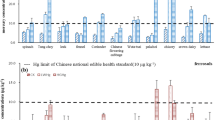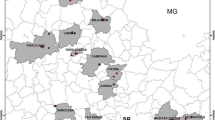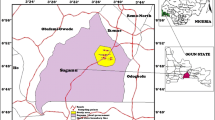Abstract
Purpose
This work was performed to reveal the influences of the soil properties (OM, CEC, silt and clay content), on the translocation of W, from soil to vegetables, under agrarian system (soil to vegetables), in low acidic conditions.
Materials and methods
A total of one hundred and thirteen (113) vegetable samples of (5) different types, and the corresponding surface soil samples, were collected from (5) main cities in Fujian Province of southeastern China.
Results and discussion
The results showed that the total and available soil W ranged from 0.05 to 28.48 and 0.02 to 2.40 mg kg−1, respectively, and were significantly correlated (r = 0.756**, n = 113). The W concentration in the vegetables ranged between 0.02 to 13.03 mg kg−1, with an average of 0.59 mg kg−1. Among the different vegetable types, the mean W concentrations were between 0.03 mg kg−1 and 2.73 mg kg−1. Lotus seed (Nelumbo nucifera) and spinach (Spinacia oleracea) contained the lowest (0.03 mg kg−1), and highest mean W concentrations (2.73 mg kg−1), respectively. Also, the W transfer from soil to vegetables based on (TFavail) decreased in the order of radish (Raphanus sativa) (28.01) > spinach (Spanacia oleracea) (11.35) > potato (Solanum tuberosum) (1.36) > lotus root (Nelumbo nucifera) (0.77) > corn (Zea mays) (0.32) > lotus seed ((Nelumbo nucifera) (0. 30).
Conclusions
Among the soil properties, the OM, CEC, and silt and clay content showed significantly negative correlations, with TFavail, indicating that the CEC, silt and clay contents, and OM of the soils were the main soil properties influencing the transfer of W from the soil to the vegetable (edible parts), under field conditions. The estimated daily intake revealed that the local residents may be exposed to health risks by consuming leafy vegetable produced from the investigated areas; therefore, more attention should be given to the cultivation process and consumption of the leafy vegetable produced from these study areas.




Similar content being viewed by others
References
Beesley L, Dickinson NM (2010) Carbon and trace element mobility soils amended with green waste compost. J Soils Sediments 10:215–222
Bowen HJM (1979) Environmental chemistry of the elements. Academic Press, London
Brueschweiler B, Waber U, Gupta S (2009) Tungsten, a new vegetable contaminant needs further elaborated evaluation. Toxicol Lett 189:219. https://doi.org/10.1016/j.toxlet.2009.06.509
CGS (China Geological Survey) (2005) Ecological geochemical sample analysis technical requirements (for Trial Implementation) (DD2005/03) (in Chinese)
Chen LZP and K J LN (1994) Etiology of lung cancer for different dust exposed workers; relation between silica or silicosis and lung cancer. 20
Clausen JL, Taylor S, Larson SL, Bednar AJ, Ketterer M, Griggs CS, Lambert DJ, Hewitt AD, Ramsey CA, Bigl SR, Bailey RN, Perron NM (2007) Fate and transport of tungsten Camp Edwards small arms ranges. ERDC TR-07-5. Engineer Research and Development Center, cold regions research and Engineering Laboratory, Hanover
CNEMC (China National Environmental Monitoring Center) (1990) Elemental background values of the soils in China. China Environmental Science Press, Beijing (in Chinese)
Duke JA (1970) Ethnobotanical observations on the Choco Indians. Econ Bot 23:344
Eriksson JE (2001) Concentrations of 61 trace elements in sewage sludge, farmyard manure, mineral fertilizers, precipitation and in oils and crops. Swedish EPA Rep 5159, Stockholm
Ezzati M, Lopez AD, Rodgers A, van der Hoorn S, Murray CJL (2002) Selected major risk factors and global and regional burden of disease. Lancet 360:1347–1360
French C, Dickinson NM, Putwain P (2006) Woody biomass phytoremediation of contaminated brownfield Iand. Environ Pollut 141:387–395
Fu MH, Tabatabai MA (1988) Tungsten contents of soils, plants and sewage sludges in Iowa. J Environ Qual 17:146–148
Furr AK, Lawrence AW, Tong SSC (1976) Multi element and chlorinated hydrocarbon analysis of municipal sewage sludges of American cities. Environ Sci Technol 10(7):683–687
Gbaruko BC, Igwe JC (2007) Tungsten: occurrence, chemistry, environmental and health exposure issues. Glob J Environ Res 1(1):27–32
Gee GW, Bauder JW (1976) Particle size analysis by hydrometer: a simplified method for routine textural analysis and a sensitivity test of measurement parameters. Soil Sci Soc Am J 43:1004–1007
Greger M (1999) Metal availability and bio concentration in plants. In: Prasad MNV, Hagemeyer J (eds) Heavy metal stress in plant from molecules to ecosystems. Springer, Berlin, pp 155–176
Hu WY, Chen Y, Huang B, Niedermann S (2014) Health risk assessment of heavy metals in soils and vegetables from a typical greenhouse vegetable production system in China. Hum Ecol Risk Assess 20:1264–1280
Hu W, Huang B, Tian K, Holm PE, Zhang Y (2017) Heavy metals in intensive greenhouse vegetable production systems along Yellow Sea of China:levels, transfer and health risk. Chemosphere 167:82–90
James B, Zhang W, Sun P, Wu M, Li HH, Khalid MA, Jayasuriya M, James S, Wang G (2017) Tungsten (W) bioavailability in paddy rice soils and its accumulation in rice. Int J Environ Health Res 26(6):487–497
Jarup L (2003) Hazards of heavy metals concentration. Br Med Bull 68:166–183
Johannesson KH, Dave HB, Mohajerin TJ, Datta S (2006) Controls on tungsten concentrations in groundwater flow systems:the role of adsorption,aquifer sediment Fe(lll) oxide/oxyhydroxide content, and thiotungstate formation. Chem Geol 351:76–94
Kelly ADR, Lemaire M, Young YK, Eustache JH, Guilbert C, Molina MF, Mann KK (2013) In vivo tungsten exposure alters B-cell development and increases DNA damage in murine bone marrow. Toxicol Sci 131:434–446
Khan S, Cao Q, Zheng YM, Huang YZ, Zhu YG (2008) Health risks of heavy metals in contaminated soils and food crops irrigated with wastewater in Beijing, China. Environ Pollut 152:686–692
Laulicht F, Brocato J, Cartularo L, Vaughan J, Wu F, Kluz T, Sun H, Oksuz BA, Shen S, Peana M, Medici S, Zoroddu MA, Costa M (2015) Tungsten-induced carcinogenesis in human bronchial epithelial cells. Toxicol Appl Pharmacol 288:33–39
Lock K, Pomerleau J, Cause L, Altmann DR, McKee M (2005) The global burden of disease attributable to low consumption of fruit and vegetables: implications for the global strategy on diet. Bull World Health Organ 83:100–108
MAPRC (Ministry of Agriculture of the People's Republic of China), 2006. Soil testing Part 9: Method for determination of soil available molybdenum. NY/Y 1121, 9–2006
Marcshner H (1995) Mineral nutrition of higher plants, 2nd edn. Academic Press, London
Pyatt FB, Pyatt AJ (2004) The bioaccumulation of tungsten and copper by organisms inhabiting metalliferous areas in North Queensland, Australia: an evaluation of potential health implications. J Environ Health Res 3:13–18
Quin BF, Brooks RR (1972) The rapid determination of tungsten in solid, stream sediments, rocks and vegetation. Anal Chim Acta 58:301–309
Rhodes J (1982) Cation exchange capacity. Methods of soil analysis. Part 2. Chemical and microbiological properties. American Society of Agrononmy, Soil Science Society of America, pp 149–157
Sanitary Rules and Norms of Russian Federation (1996) Moscow
Sen Tuna G, Braida W, Ogundipe A, Strickland D (2012) Assessing tungsten transportin the vadose zone: from dissolution studies to soil columns. Chemosphere 86:1001–1007
Steenland K, Boffeta P (2000) Pb and cancer in humans: where are we now? Am J Ind Med 38:295–299
Tessier A, Campbell PGC, Bisson M (1979) Sequential extraction procedure for the speciation of particulate trace metals. Anal Chem 51:844–851
Wang G, Su MY, Chen YH, Lin FF, Luo D, Gao SF (2006) Transfer characteristics of cadmium and lead from soil to the edible parts of six vegetable species in southeastern China. Environ Pollut 144:127–135
White PJ, Pongrac P (2017) Heavy-metal toxicity in plants. In: Shabala S (ed) Plant stress physiology, second edn. CABI, Boston, p 300
WHO (World Health Organisation) (1992) Cadmium environmental health criteria.Geneva, p 134
WHO (World Health Organisation) (1998) Health guideline for the use of wastewater in agriculture and aquaculture. Report of WHO science group, Geneva, Switzerland. Tech Rep Sci 778:10
WHO (World Health Organisation) (2003) Diet, nutrition and the prevention of chronic diseases. Report of a Joint FAO/WHO Expert Consultation. WHO Technical Report Series No. 916. Geneva, Switzerland
Wilson B, Pyatt FB (2006) Bioavailability of tungsten and associated metals in calcareous soils in the vicinity of an ancient metalliferous mine in the Corbieres area, southwestern France. J Toxicol Environ Health A 72:807–816
Xin LJ, Wang JY, Wang LX (2015) Prospect of per capita grain demand driven by dietary structure change in China. Resour Sci 37:1347–1356
Xu N, Braida W, Christodoulatos C, Chen J (2013) A review of molybdenum adsorption in soils/ bed sediments: speciation, mechanism, and model applications. Soil Sediment Contam 22:912–929
Xu L, Lu A, Wang J, Ma Z, Pan L, Feng X, Luan Y (2015) Accumulation status, sources and phytoavailability of metals in greenhouse vegetable production systems in Beijing, China. Ecotox Environ Safe 122:214–220
Xue ZJ, Liu SQ, Liu YL, Yan YL (2012) Health risk assessment of heavy metals for edible parts of vegetables grown in sewage-irrigated soils in suburbs of Baoding City, China. Environ Monit Assess 184:3503–3513
Yang L, Huang B, Hu W, Chen Y, Mao M, Yao L (2014) The impact of greenhouse vegetable farming duration and soil types on phytoavailability of heavy metals and their health risk in eastern China. Chemosphere 103:121–130
Zhuang P, McBride MB, Xia H, Li N, Li N, Li Z (2009) Health risk from heavy metals via consumption of food crops in the vicinity of Dabaoshan mine, South China. Sci Total Environ 407(5):1551–1561
Acknowledgments
We are indebted to Jiang Ling for technical support with the Elementar Vario-Max CN Elementar analyzer. The chemical and laboratory analysis (bioavailable extraction of W and soil measurement), was assisted by Swithin James.
Author information
Authors and Affiliations
Contributions
Field sampling and experimental design was initiated by Professor Guo Wang and carried out by Blessing James (Doctoral degree study) (Ph.D Research Candidature “degree”). The chemical and laboratory analysis (bioavailable extraction of W & soil measurement) was coordinated by Blessing James and assisted by Swithin James; implemented the data analysis and manuscript drafting/ review was implemented by BJ and GW.
Corresponding author
Ethics declarations
Conflict of interest
The authors declare that they have no conflict of interest.
Additional information
Responsible editor: Xilong Wang
Publisher’s note
Springer Nature remains neutral with regard to jurisdictional claims in published maps and institutional affiliations.
Rights and permissions
About this article
Cite this article
James, B., Wang, G. Accumulation characteristics of tungsten (W) and its potential health risk assessment in the soil-vegetable system under field conditions. J Soils Sediments 20, 599–608 (2020). https://doi.org/10.1007/s11368-019-02411-6
Received:
Accepted:
Published:
Issue Date:
DOI: https://doi.org/10.1007/s11368-019-02411-6




